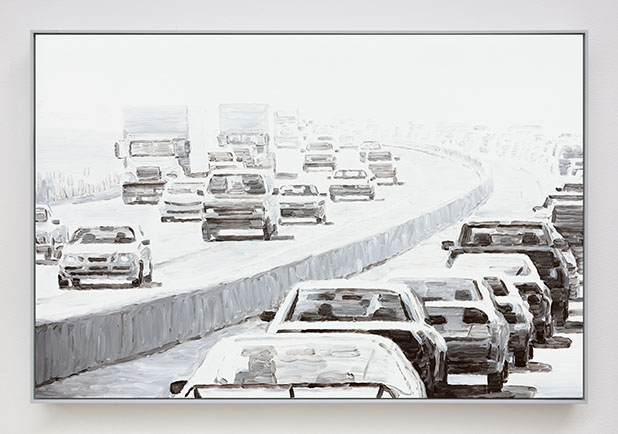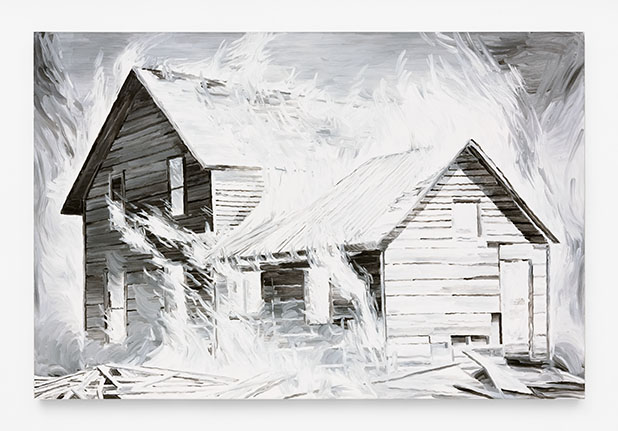“Elegy,” the title of Cynthia Daignault’s show, referenced Robert Motherwell’s 1948-1967 “Elegies to the Spanish Republic.” In contrast to his abstractions mourning the results of the Spanish Civil War, her representational portrayals lament the passage of time, with a particular emphasis on environmental degradation and cultural ebb.
Depicting iconic U.S. landscapes alongside a medley of subjects culled from movies and recent history, Daignault’s grisailles evoked gray dreams, newspapers’ black-and-white and silvery films of yore. Mostly 30” lengthwise, canvases were hung in close succession like a roll of film stretched across walls. This arrangement conveyed the staccato feel of a slideshow, with each painting a frame depicting something different from the last. A tombstone, a tract house, a dozing newborn, an equine’s roped head: the miscellaneous subjects didn’t make sense together; and why should they have? Dreams don’t make sense; the news doesn’t add up; culture is a haphazard patchwork. Individuals must pluck their own harmonies from the discord.
Initially, her images’ collocation appeared arbitrary; yet the longer you looked, the more they coalesced. Similar subjects were often paired; such as a windshield view of mountains, Elegy (Windshield) (all works 2019), placed next to Elegy (Freeway), depicting smog-laced traffic. Occasionally, the sequence conveyed the impression of a lens zooming in or out: Elegy (Mustang) could have been a close-up of the rearing steed in the next painting.
Appearing most frequently were natural vistas—Mt. Whitney, a glacier, a bristlecone pine—as one might see in a national park. These pristine sceneries were interspersed with allusions to mortality and horror: an atomic cloud mushrooming over Hiroshima, a crow attack scene from Hitchcock’s The Birds. A portrait of John Muir left little doubt as to the artist’s concern for nature, particularly as the government is seeking to reduce public lands. However, to stop at this interpretation would be to miss the timelessness of her musings on temporality.
A painting is a bet against time: the artist spends hours on a piece in an attempt to preserve a transient scene, along with her name, for posterity. Likewise, viewers look to gain something outlasting their spell invested. Daignault’s linear succession heightened one’s awareness of the period spent in front of each painting; at intervals, her evocative brushwork lured you closer, entreating you to stop. The slight haziness of her gray impressionism underscored the intervention of time and her hand. Inklings of self-referentiality permeated Elegy (Helen), portraying the late Helen Frankenthaler—who, like Daignault, distilled her impressions of nature—at work on a painting. Subsequent was Daignault’s painting of Arlington Cemetery. Departing the gallery, visitors passed Elegy (Five Minutes to Midnight), a stark portrayal of a clock foretelling the end of the eleventh hour. Tempus edax rerum.



